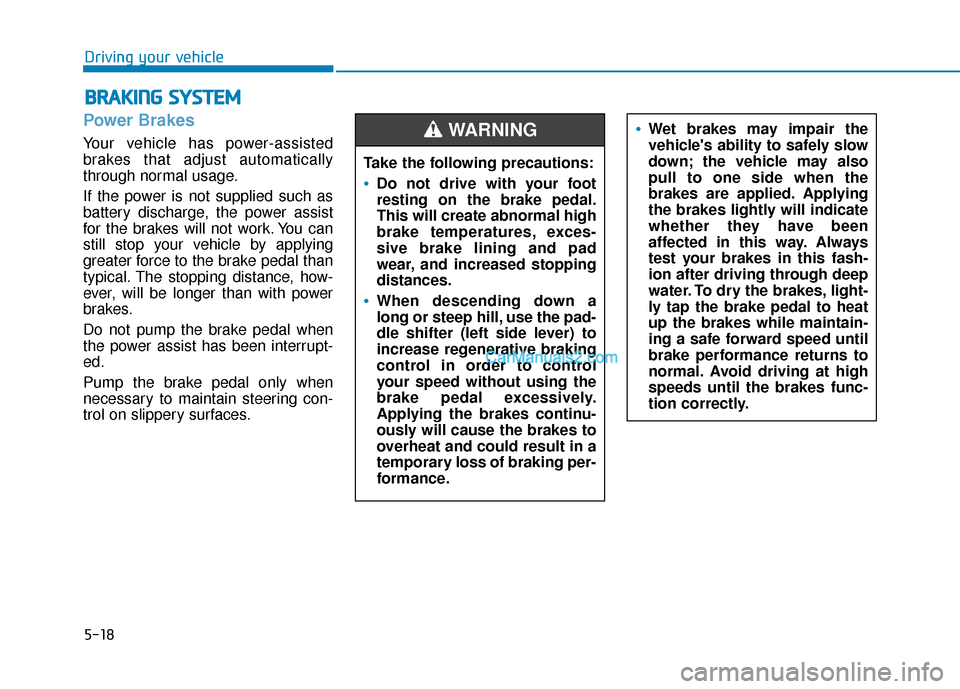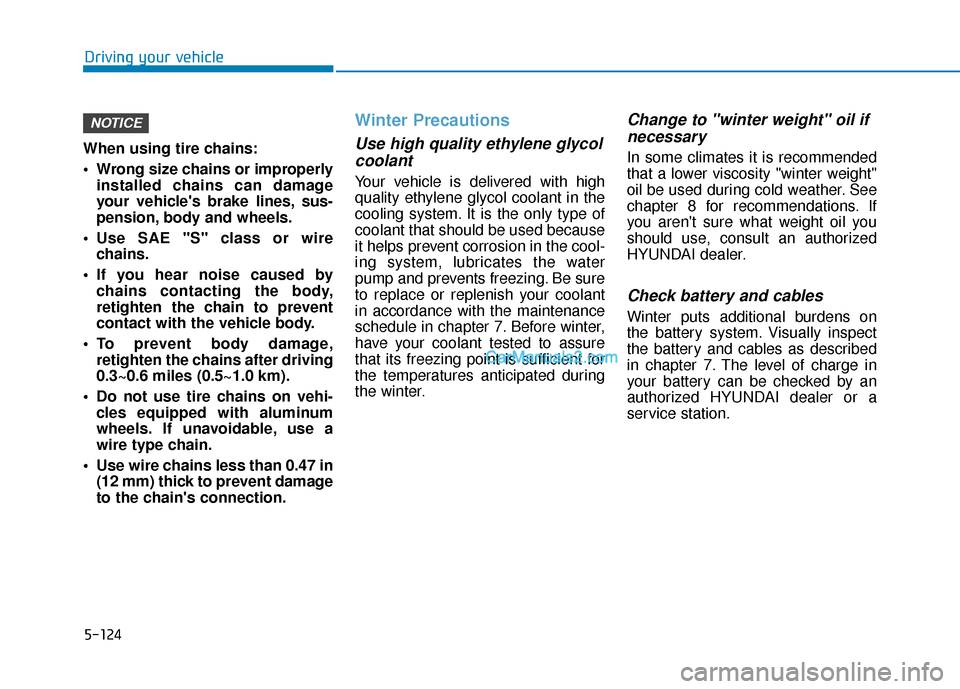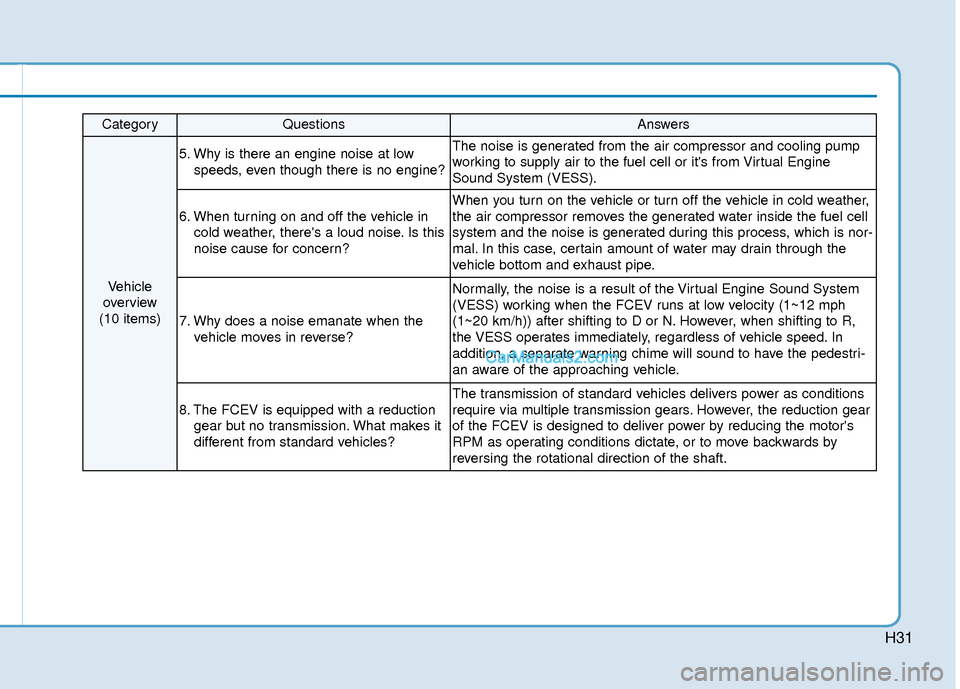water pump Hyundai Nexo 2019 Owner's Manual
[x] Cancel search | Manufacturer: HYUNDAI, Model Year: 2019, Model line: Nexo, Model: Hyundai Nexo 2019Pages: 560, PDF Size: 24.2 MB
Page 284 of 560

5-18
Power Brakes
Your vehicle has power-assisted
brakes that adjust automatically
through normal usage.
If the power is not supplied such as
battery discharge, the power assist
for the brakes will not work. You can
still stop your vehicle by applying
greater force to the brake pedal than
typical. The stopping distance, how-
ever, will be longer than with power
brakes.
Do not pump the brake pedal when
the power assist has been interrupt-
ed.
Pump the brake pedal only when
necessary to maintain steering con-
trol on slippery surfaces.
B BR
RA
A K
KI
IN
N G
G
S
S Y
Y S
ST
T E
EM
M
Driving your vehicle
Take the following precautions:
Do not drive with your foot
resting on the brake pedal.
This will create abnormal high
brake temperatures, exces-
sive brake lining and pad
wear, and increased stopping
distances.
When descending down a
long or steep hill, use the pad-
dle shifter (left side lever) to
increase regenerative braking
control in order to control
your speed without using the
brake pedal excessively.
Applying the brakes continu-
ously will cause the brakes to
overheat and could result in a
temporary loss of braking per-
formance.
Wet brakes may impair the
vehicle's ability to safely slow
down; the vehicle may also
pull to one side when the
brakes are applied. Applying
the brakes lightly will indicate
whether they have been
affected in this way. Always
test your brakes in this fash-
ion after driving through deep
water. To dry the brakes, light-
ly tap the brake pedal to heat
up the brakes while maintain-
ing a safe forward speed until
brake performance returns to
normal. Avoid driving at high
speeds until the brakes func-
tion correctly.WARNING
Page 390 of 560

5-124
Driving your vehicle
When using tire chains:
Wrong size chains or improperly installed chains can damage
your vehicle's brake lines, sus-
pension, body and wheels.
Use SAE "S" class or wire chains.
If you hear noise caused by chains contacting the body,
retighten the chain to prevent
contact with the vehicle body.
To prevent body damage, retighten the chains after driving
0.3~0.6 miles (0.5~1.0 km).
Do not use tire chains on vehi- cles equipped with aluminum
wheels. If unavoidable, use a
wire type chain.
Use wire chains less than 0.47 in (12 mm) thick to prevent damage
to the chain's connection.
Winter Precautions
Use high quality ethylene glycolcoolant
Your vehicle is delivered with high
quality ethylene glycol coolant in the
cooling system. It is the only type of
coolant that should be used because
it helps prevent corrosion in the cool-
ing system, lubricates the water
pump and prevents freezing. Be sure
to replace or replenish your coolant
in accordance with the maintenance
schedule in chapter 7. Before winter,
have your coolant tested to assure
that its freezing point is sufficient for
the temperatures anticipated during
the winter.
Change to "winter weight" oil ifnecessary
In some climates it is recommended
that a lower viscosity "winter weight"
oil be used during cold weather. See
chapter 8 for recommendations. If
you aren't sure what weight oil you
should use, consult an authorized
HYUNDAI dealer.
Check battery and cables
Winter puts additional burdens on
the battery system. Visually inspect
the battery and cables as described
in chapter 7. The level of charge in
your battery can be checked by an
authorized HYUNDAI dealer or a
service station.
NOTICE
Page 535 of 560

H31
CategoryQuestionsAnswers
Vehicle
overview
(10 items)
5. Why is there an engine noise at low speeds, even though there is no engine?The noise is generated from the air compressor and cooling pump
working to supply air to the fuel cell or it's from Virtual Engine
Sound System (VESS).
6. When turning on and off the vehicle incold weather, there's a loud noise. Is this
noise cause for concern?
When you turn on the vehicle or turn off the vehicle in cold weather,
the air compressor removes the generated water inside the fuel cell
system and the noise is generated during this process, which is nor-
mal. In this case, certain amount of water may drain through the
vehicle bottom and exhaust pipe.
7. Why does a noise emanate when thevehicle moves in reverse?
Normally, the noise is a result of the Virtual Engine Sound System
(VESS) working when the FCEV runs at low velocity (1~12 mph
(1~20 km/h)) after shifting to D or N. However, when shifting to R,
the VESS operates immediately, regardless of vehicle speed. In
addition, a separate warning chime will sound to have the pedestri-
an aware of the approaching vehicle.
8. The FCEV is equipped with a reductiongear but no transmission. What makes it
different from standard vehicles?
The transmission of standard vehicles delivers power as conditions
require via multiple transmission gears. However, the reduction gear
of the FCEV is designed to deliver power by reducing the motor's
RPM as operating conditions dictate, or to move backwards by
reversing the rotational direction of the shaft.